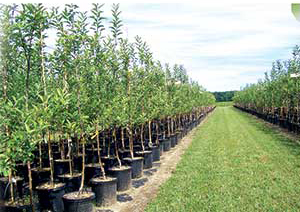
Urban landscaping with root balled trees a green-wash?
-tas-2.jpg)
Any national level project focusing environmental improvements through tree plantation should be based on increasing the total tree cover of the country at national level rather than shifting trees from one place to another as currently practiced through root balling methods for our urban landscaping programs. This root balling process also damages the environment of the original location as well, because of disturbance to other plants around it during balling operation. Also the root balled trees are very expensive when compared with the maintenance cost of a small plant to achieve the same height in a nursery.
Also the survival rate of root balled trees is also very low because of difficulty in adapting to new environment.Even newly planted trees have to be maintained at for least for six months to establish its roots to the new environment. This is very difficult task for root balled big trees because they are accustomed to original environment for long time. This is also a very expensive operation for plantation on a large scale like avenue planting in urban landscaping projects. However, this is not so for small plants about 2-3 ft. height grown in nurseries.
Another issue is the sustainability of newly planted trees. If someone takes interest of evaluating the sustainability rate of trees planted in these so called Tree Planting Campaigns inaugurated by politicians you can understand what I am trying to convey. I am sure it is less than 10% because of lack of maintenance after the inauguration. Maintenance should be done by regular watering and fertilizing at least for three months. Otherwise those inaugurations are simply Green Washing programs cheating ourselves.
I think above facts should be taken into consideration in planting trees in urban landscaping programs now in progress in Colombo City. Otherwise it could be a green-wash similar to whitewash.
Foliage planted in front of Temple Trees is a good example of such waste. My layman’s view is that plants grown in nurseries should be promoted for national level projects.
It is only a matter of maintaining those plants for some time until it grows to a safe height beyond which it is self-sustaining. It will help small scale nursery owners too.
Perhaps experts will shed light on this issue?
source :The Island 2016/08/06 http://www.island.lk/index.php?page_cat=article-details&page=article-details&code_title=149892
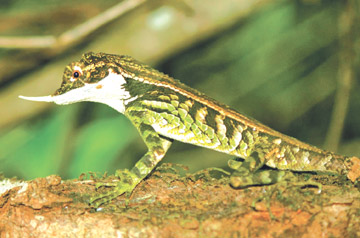
A clarion call for stronger action on wildlife trade
It only takes a simple search online, to find various types of endemic species of Sri Lanka, to purchase. From various types of spiders, to snakes and lizards as well as star tortoises, rare species are available for purchase at the click of a mouse. A shocking and alarming situation for environmentalists and conservationists, the racket has been going on with valuable species being smuggled out of the country to be sold as pets or prized possessions of collectors.
Environmentalists and wildlife experts claim that the rampant illicit wildlife trade within the country has caused the rapid depletion of Sri Lanka’s wildlife resources, while also gradually turning Sri Lanka into a transit hub for international illicit wildlife trade.
Despite major busts in recent times, by various government agencies, according to them the main obstacle in combating and curbing the illicit trade is getting the government genuinely interested in eradicating the poaching and smuggling of wildlife.
“No government past or present has taken a bona fide interest in curbing the illicit trade of wildlife in Sri Lanka,” charges former Director General, Sri Lanka Customs, Samantha Gunasekara. An environmentalist himself, Gunasekara says, the illicit trade of wildlife cannot be stopped if the government does not take positive and honest steps to combat it.
The illicit wildlife trade has become a major issue in Sri Lanka due to the country’s geographical location and rich biodiversity. This according to experts, has made it a key player in the local, regional and international illicit wildlife trade in recent times.
(Seahorses – Smuggled from India to Sri Lanka through sea for transit)
“The annual illicit trade is around US$ 150 – 268 Billion worldwide” Gunasekara claims. However, the real figures are much higher than that documented, he says.
Conservation International, an environmental activist group has identified Sri Lanka as one of the 25 leading and threatened biodiversity hotspots around the world. According to Gunasekara, Sri Lanka is among the top eight biodiversity hotspots due to the large number of endemic species found in the island.
Threatened
“While we have a large number of endemic species, many of them are threatened as most are concentrated in the southwestern part of the country where human population and activity are high” Gunasekara said.
With the country being rich in biodiversity, illegal traders may take the pick of the crop.
A species that had no demand 20 years ago, Sri Lanka today is number one exporter of Manta Rays. “There is a high demand for the item in the Far East, especially, in Hong Kong where it is considered a delicacy” says Gunasekara adding that there are no regulations in the country to protect the species. The Manta Ray is a protected species in international waters under the Convention on the Conservation of Migratory Species of Wild Animals and Sri Lanka being a signatory to the Convention should be looking into the protection of the species.
According to Dinal Samarasinghe, Research and Project Officer of Environmental Foundation Limited, star tortoises and black tortoises too are popular commodities in the illicit trade.
“They are sold as pets,” he said, adding that Lizards and Butterflies endemic to Sri Lanka too can be easily found for purchase online, particularly in Europe.
A report compiled by Sandra Altherr in 2014 found that many rare species of Sri Lankan reptiles such as the Rhino horn lizard, Pygmy Lizard, Black Cheeked lizard and the hump snout lizard are being openly traded online in Europe causing grave concern among conservationists and environmentalists locally and internationally, as many of these species are vulnerable to extinction. The demand for edible birds’ nests, seashells, various types of fish and plants such as walla patta too remain high in the list.
Gunasekara claims, the country is now becoming a major transit point in the region for seahorses, sandalwood, red sanders, rosewood and ivory. “However, through detections and busts the trade has dwindled,” he said.
Nonetheless, syndicates that run international illicit wildlife trade rings continue to use Sri Lankan waters to smuggle their goods, while avoiding Sri Lankan ports due to heightened monitoring by the authorities, he said.
While internationally and regionally the mentioned species are in demand, the trade of elephants locally, has become one of the most serious, in recent times.
According to Gunasekara the value of an elephant calf soared with the rise of the local trade. “Just 10 years ago an elephant calf cost one million rupees, but by last year it increased to Rs.30 million due to the local trade,” he said.
Wildlife poaching and smuggling is carried out for bush meat, while killing animals to obtain parts based on mythical beliefs too is common in the country.
(Rose wood bust by customs while transiting from Sri Lanka)
Samarasinghe says, recently a leopard which was found killed in Yala Block 3 had no teeth as they had been collected by the poacher. “There is a belief that it gives power to those who possess them,” he said.
Wildlife is smuggled out through various methods. Surprisingly, the customs have in the past made detections of sandalwood leaving the island through diplomatic cargo, while some use devious methods such as false bottoms in luggage, mixing the rare specimens among common species or changing the appearance of the smuggled wildlife.
“Wallapatta for example is almost non-existent today due to unregulated collection and trade,” says Gunasekara adding that such actions could drive the whole species to a brink of extinction while also causing the loss of aesthetic beauty of the country and an ecological imbalance.
“We lose so much of foreign exchange and revenue through the illegal trade,” he pointed out saying that it has been found that revenue from trade can even be trailed to criminal and terror organizations. Sri Lanka has been combating wildlife trade through traditional methods of detection and raids but as pointed out by the Chairman of the Industrial Technology Institute Niroshan Perera advanced technology such as the SMART conservation software, real time virtual watch rooms to combat illegal fishing, Wildscan application for species identification, Wildleaks a whistleblower website are all being used to combat the trade the world over, though they are not used in Sri Lanka, at present.
(Rhino Horned Lizard – Endemic to Sri Lanka and popular in the illicit wildlife trade. Can be found for sale online in Europe)
We use the technology available with the help of ITI to identify wildlife being smuggled,” Gunasekara said. He thinks combating the illegal trade should happen at the grassroots level.
According to Gunasekara, “the main issue is the incorrect policies of the governments.” It is seen in the existing government mechanism, where,”the policy is made by one agency, while implementation remains with yet another agency” he says. “There is just no cohesiveness in the plan” Gunasekara claims.
Environmentalist Supun Lahiru Prakash of the Biodiversity Conservation and Research Circle (BCRC) agrees.
“Two months have elapsed since the committee report on the wrongdoings of the Wildlife Department officers and involvement in the illicit trade of elephants, which has been handed over to the Minister of Sustainable Development and Environment” he says, adding that the silence on the matter is questionable. According to Gunasekara poor public participation due to lack of awareness and education in protecting wildlife also contributes to poaching and smuggling taking place freely.
While the situation is one of concern, no official from the Department of Wildlife was available for comment. With the former Director General of the Department of Wildlife Dr. Sumith Pilapitiya tendering his resignation in June no new appointment has been made yet.
(Ivory nabbed during transit before destruction in Sri Lanka)
Recommendations
Gunasekara recommends that proper and realistic policies should be implemented while rulers should have a genuine political will to make a real and lasting change. “We must address the gaps in the national legislation now,” he says.
According to Gunasekara legal validation should also be given to the Convention on International Trade in Endangered Species of Wild Fauna and Flora (CITES) which aims to ensure that international trade in specimens of wild animals and plants does not threaten their survival.
“We have been signatory to this convention for over three decades but we have not done anything yet to comply with it,” he laments.
While public education and awareness is needed, Gunasekara mentions that encouraging national pride and thinking is of utmost importance. “We must instil this in people and move them away from the currently existing indifference,” he notes.
“The thought that these depleting resources belong to all of us could make a world of difference in combating the illicit trade of Sri Lankan wildlife.”
(Source :Sunday Observer :http://www.sundayobserver.lk/2016/07/31/fea15.asp)
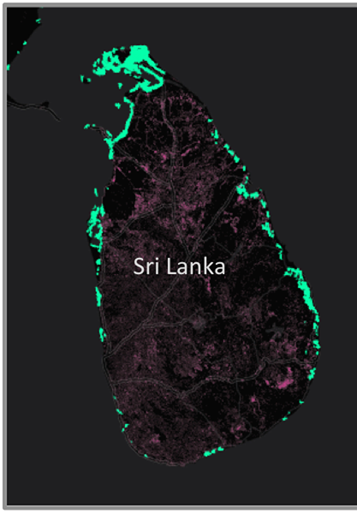
Sri Lanka set to become first nation to protect all mangroves
Sri Lanka’s president announced new mangrove protection measures – and inaugurated a museum that aims to teach people about the value of these globally threatened, coastal forests.
Mangroves provide many ecosystem services, from protecting shorelines and serving as nurseries for fishes and crustaceans to sequestering carbon.
Mangroves are one of the most threatened tropical ecosystems on the planet, declining by more than 50 percent in as many years.
Major drivers of mangrove deforestation include conversion for agricultural purposes, dam-building, and firewood collection. Scientists believe rising sea levels from global warming will be a big future threat.
Sri Lanka’s new museum is part of a project launched last year that aims to protect the country’s 8,800 hectares of mangrove forests and restore 3,900 hectares. The museum seeks to attract more than 20,000 visitors in its first year.
The tropical island-nation of Sri Lanka is getting its own mangrove museum. The museum, inaugurated by the Sri Lankan president Maithripala Sirisena today, will showcase how mangroves – saltwater-adapted forests found along coastal areas – contribute to ecosystems and livelihoods in the region.
Tucked away in a shaded spot at the edge of a mangrove forest on the western coast of the country, the museum seeks to attract more than 20,000 schoolchildren and eco-tourists in its first year.
“Mangroves swiftly absorb carbon dioxide and inject oxygen into the atmosphere, maintaining an ecological balance vital for the environment,” Prime Minister Ranil Wickremesinghe said in a statement. “It is my belief that the mangrove restoration project will generate much-needed awareness among key stakeholders such as the community, leisure sector personnel, tourists, and the general public.”

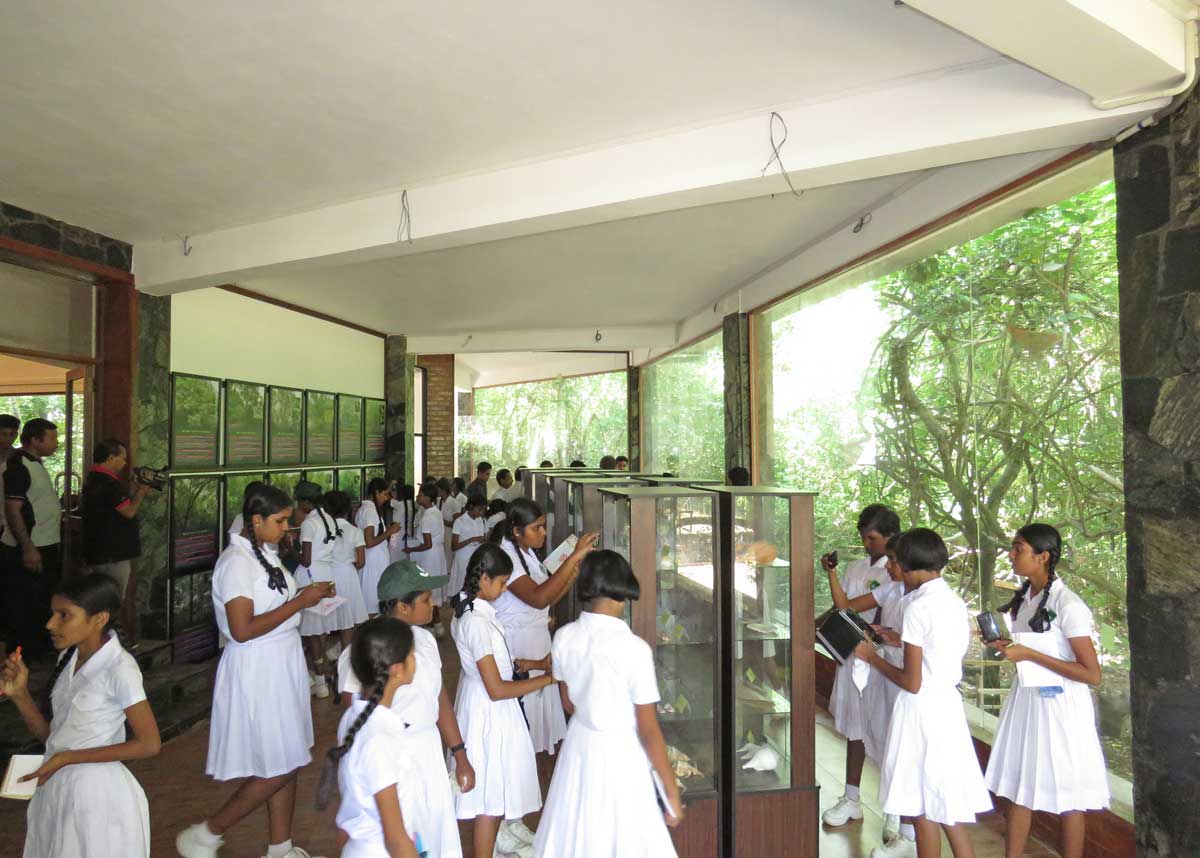
The museum is part of a nationwide project launched last year, funded by Seacology, a U.S. based island conservation organization, and executed by Sudeesa, a local NGO, earlier known as Small Fishers Federation of Sri Lanka.
The five-year project, which will cost $3.4 million, aims to protect Sri Lanka’s existing 8,800 hectares (34 square miles) of mangrove forests and to restore 3,900 hectares (15 square miles). Raising awareness of the value of mangroves is crucial, say those involved, since the project relies on local communities to protect mangroves by helping them adopt alternative livelihoods that don’t involve destroying mangrove forests.
Referred to as “magical” by Mary Randolph, a program manager at Seacology, mangroves play a role in many critical ecosystem services from protecting shorelines and serving as nurseries for fishes and crustaceans to sequestering carbon more efficiently than other types of forests.
According to Seacology, over half of the world’s mangroves – one of the planet’s most endangered tropical ecosystems – were lost to human disturbance in the past 50 years. Current global threats include the conversion of mangroves for aqua- and agriculture, damming rivers that supply fresh water and sediment to the trees, and rising seas fueled by global warming.
Sri Lanka has also seen its mangroves disappear, but accurate estimates for the rate of loss are difficult to find because little information exists about the country’s historical extent of mangrove cover. However, satellite data indicate Sri Lanka’s mangroves have experienced less recent degradation compared to many other countries.
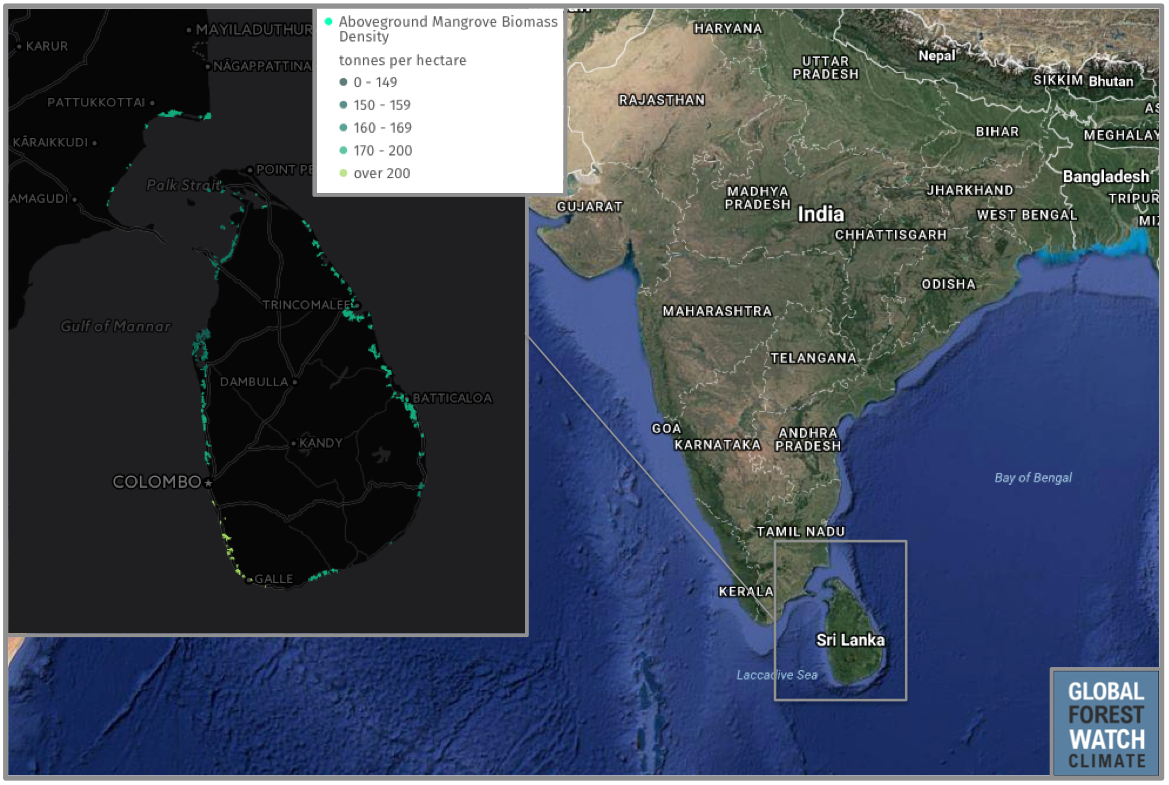
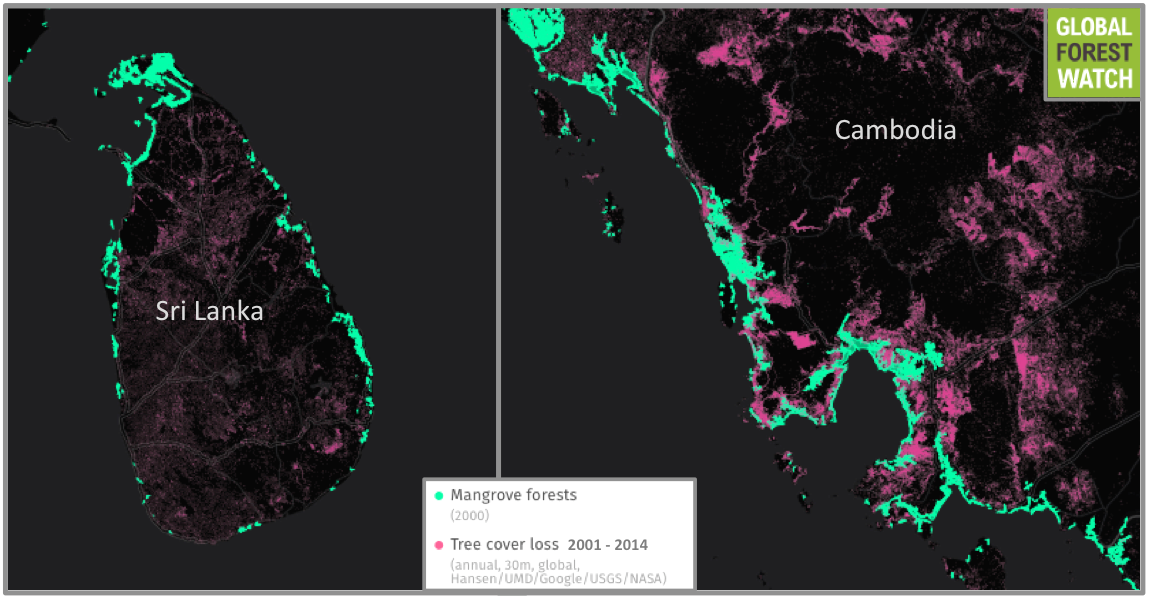
One of the first steps taken by the Sri Lankan government as part of this newest initiative was to survey and identify the country’s mangrove forests.
“The government of Sri Lanka has for the first time legally demarcated about 50 percent of all its mangrove forests [as protected areas],” Duane Silverstein, Executive Director of Seacology, told Mongabay. Sri Lanka has committed to protect all its mangroves going forward, the first and only country to do so.
Tundi Agardy, who heads the Marine Ecosystem Services Program at the NGO Forest Trends, attributed the thrust towards legal protection to the realization that mangroves act as shoreline protection. The importance of mangroves as natural buffers was driven home during the devastating tsunami that struck Sri Lanka in 2004 killing more than 30,000 people. Areport by the International Union for Conservation of Nature (IUCN) the following year assessed the impact on two coastal villages and found that there were two fatalities in the village that had a thick mangrove and scrub forest, while the other village that did not have such vegetation suffered almost 6,000 deaths.
“We can let the mangroves die or be cut off and put in place built structures to protect the shorelines,” Agardy said in an interview “It is just much more cost efficient to let nature do this for us.”
The breadth of Sri Lanka’s mangrove protection laws makes them different from the country’s other conservation laws.
“These laws are very unique because they single out not just an ecosystem or a geographic area like a coastal zone but they’re talking very specifically about a suite of plant species that need to be protected,” she noted.
Mangroves are mostly concentrated in the tropical and subtropical belts and are adapted to survive in harsh conditions like high salinity, low oxygen, strong winds, and high light intensity. However, anthropogenic influences have proven harder to survive.

“The biggest threats to mangroves in Sri Lanka include prawn farms, which have been greatly curtailed in recent years, collateral damage from the civil war, and impoverished people cutting down mangroves to use or sell as charcoal,” Silverstein said.
The new museum features installations showcasing the 22 species of mangrove trees found in Sri Lanka, as well as the fish and other wildlife that depend on mangrove-dominated ecosystems.
“It is a public recognition of the importance of mangroves, and educating people about how the economy and culture of this place depends so much on this ecosystem,” said Seacology’s Mary Randolph.
Recent interest in mangroves has been spurred by the discovery that mangrove forests are among the most carbon-rich habitats on earth. According to some estimates, mangroves fix three to five times more carbon than other forest types.
“They sequester carbon in the wood in the trunks and branches of the tree but the really big carbon sink is below ground and is formed by the roots of the mangroves,” said Karen L. McKee, a plant ecologist who specializes in wetland ecology. She added “when they die they do not decay quickly because the flooding retards the rate of decay of organic matter.” Mangroves produce biomass at a very rapid rate and combined with the slow decay, this leads to faster carbon accumulation.
While carbon sequestration and potential economic benefits from it have attracted some stakeholders, McKee told Mongabay that it would be a mistake to focus on just this one function. “We should not lose sight of the range of services that they provide.”
Citations:
Giri C, Ochieng E, Tieszen LL, Zhu Z, Singh A, Loveland T, Masek J, Duke N (2011). Status and distribution of mangrove forests of the world using earth observation satellite data (version 1.3, updated by UNEP-WCMC). Global Ecology and Biogeography 20: 154-159. doi: 10.1111/j.1466-8238.2010.00584.x . Data URL: http://data.unep-wcmc.org/datasets/4Hutchison J, Manica A, Swetnam R, Balmford A, Spalding M (2014) Predicting global patterns in mangrove forest biomass. Conservation Letters 7(3): 233–240. doi:
Hutchison J, Manica A, Swetnam R, Balmford A, Spalding M (2014) Predicting global patterns in mangrove forest biomass. Conservation Letters 7(3): 233–240. doi: http://dx.doi.org/10.1111/conl.12060; Data URL:http://data.unepwcmc.org/datasets/39. Accessed through Global Forest Watch on [date]. www.globalforestwatch.org
Source :03/08/2016 Mongaby https://news.mongabay.com/2016/07/sri-lanka-set-to-become-first-nation-to-protect-all-its-mangroves/
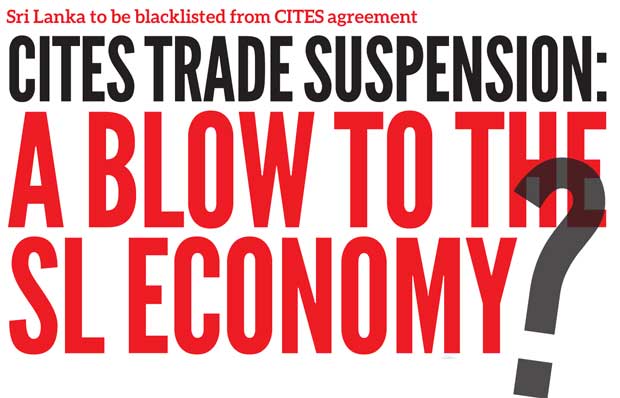
CITES trade suspension: A blow to the SL economy
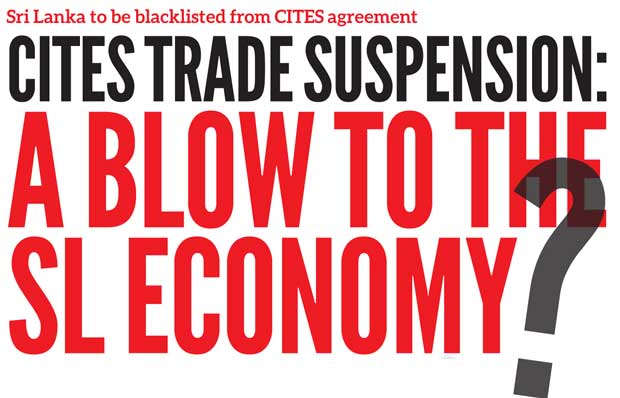
The Convention on International Trade in Endangered Species of Wild Fauna and Flora, globally known as CITES, is an international treaty which has been signed among governments to ensure that international trade in specimens of wild animals and plants does not threaten their survival. Sri Lanka has been party to this agreement for over 20 years but the poorly structured national legislation has confined Sri Lanka to ‘Category 3’.
In a Notification document which was drafted earlier this year, it was stated that Sri Lanka was still a Category 3 Party due to poor national legislation to implement CITES which in other words mean that Sri Lanka doesn’t have the necessary legislation but has been Party to the Convention for more than twenty years as of March 2013. Therefore Sri Lanka would face “a suspension of commercial trade in specimens of CITES-listed species”. Upon being blacklisted by this specific convention, Sri Lanka will be deprived of its GSP Plus concession as well.
Is it really a matter of legislation? How far should domestic legislation reach? How can this suspension be overcome? In order to shed light on these issues, the Daily Mirror spoke to a few individuals of expertise:
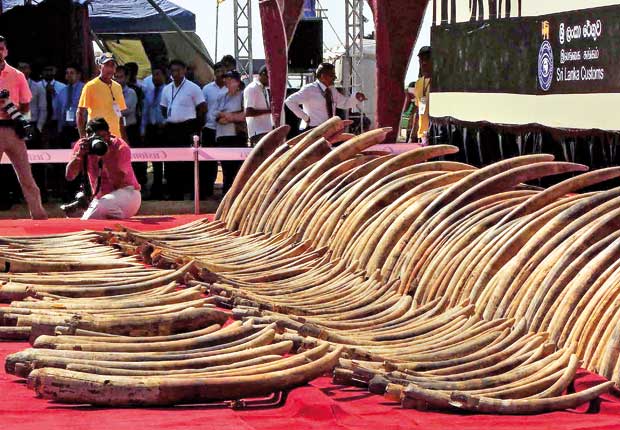
“Domestic legislation doesn’t address international trade adequately”
Manori GunawardenaCountry representative to the Born Free Foundation, Manori Gunawardena said that Sri Lanka has been a signatory to CITES since 1978, thereby demonstrating a strong commitment to the protection of species endangered by international commercial trade. “Sri Lanka’s national legislation is strong on conserving listed species from exploitation and is committed to protecting its natural assets within its borders. However, while domestic legislation serves to enforce infractions locally, it does not address international trade adequately.”
“Being part of a major trade route, recent detections of wildlife contraband of both native and non-native species have come to light. The detection of the large African ivory shipment, the regular confiscation of “agar wood” (“walla patta”, a native tree), and the reported online sale of endemic Sri Lankan lizards in Europe all indicate persuasive arguments to supplement the country’s domestic legislation with the provisions of CITES, a treaty to which 182 sovereign countries are signatory. Sri Lanka has taken a proactive stance in combating the illegal trade in wildlife and at the upcoming CITES meeting has co–proposed improved protection for the African elephant, Indian pangolin, mobular ray and silky and thresher shark.”
Prof. Sirimal Abeyratne“Sri Lanka shouldn’t depend on these types of concessions”
Speaking to the , Prof. of Economics Sirimal Abeyratne said that having no legislation for an issue like this is also a weakness. “The GSP Plus concession is mainly benefiting exporters because it helps them to maintain their competitiveness. But the major concern here is that these concessions should only be used temporarily. When a country is developing and has established its export market, it shouldn’t depend on these types of concessions. Such a country should compete through quality and prices.”
“The legislation will be gazetted soon” R.M.D.B Meegasmulla
Speaking to the Daily Mirror, Ministry of Sustainable Development and Wildlife secretary R.M.D.B. Meegasmulla said there was still some time remaining to get the clearance. “The Attorney General’s department has given us a clearance on this regard and we will be gazetting the legislation. We still have time till September and so far we haven’t been given a notice saying that we will be blacklisted. There were a few delays but we will recover them soon.”
“If we are black-listed it will affect our economy” Samantha Gunasekara
Speaking to the , ex-Deputy Director of Customs, Samantha Gunasekara said that for the import or the export of any species, the CITES is not a legal permit. “We first need to have the national legislation. There are 47 countries who are on the verge of getting black-listed by the CITES due to lack of proper legislation. Exotic and aquamarine species like sea horses have been listed as protected under the CITES agreement. We have signed it as facilitation but many other countries have engaged in illegal wildlife trade although they are party to the convention. If Sri Lanka gets blacklisted, it will affect our economy and the GSP Plus scheme will be removed from the country.”
“DWC has not communicated with us” CITES Secretariat
The CITES Secretariat when contacted, said “The CITES management authority in Sri Lanka, the Department of Wildlife has to date not communicated progress on national legislation to the Secretariat.”
“We are equipped with the necessary legislation” Jagath Gunawardena
Speaking to the , Environmental lawyer and Attorney-at-law Jagath Gunawardena said that in terms of legislation we have gone beyond the CITES agreement. “For example the Flora and Fauna Protection Ordinance (FFPO) Section 37 and Section 40 clearly state that the export of wild animals is illegal. But we have imposed zero tolerance on the export of wild animals or any for trade purposes. Also according to the document it is clearly visible that Sri Lanka is not alone in getting suspended. There are certain matters that need to be taken in to consideration. One is the fact that we have the proper legislation. Second is that the CITES requires a scientific body and under Section 35 of the FFPO we have many of them including Zoological Gardens. Then there should be an enforcement authority and we have the Customs department for that. Both section 40 which speaks about exports and section 35 which speaks about imports empower the Customs department to deal with such transactions as it’s an offence under the Customs Ordinance. As such these particular areas are covered. Then back in 2007 Prof. G. L. Pieris, who was the then Foreign Minister wanted compliance with the CITES for the GSP Plus. There was a committee to look in to the GSP Plus compliance and CITES was one of the requirements. The provisions in the FFPO were sufficient for the EU and therefore they granted us the GSP Plus concession.”
Stressing further on this regard, Mr. Gunawardena said that CITES is a trade convention and that it provides a way for trade. “Back in 1995 this convention downgraded the protected status of corals to Appendix 2. But in the FFPO all corals are a totally protected species and therefore we were able to circumvent any adverse situation. On the other hand, certain countries have openly violated the CITES convention when it comes to the illegal trade of ivory for example, but the CITES has not taken any action against them. Therefore we can be a party to the CITES but they can’t do anything detrimental to our position. What should be done at the moment is that someone should show the CITES that we are equipped with the proper legislation. But on the other hand there are certain species that should be protected under the CITES which we have failed to do. For example marine organisms like the manta ray and sea horse which comes under the purview of the Fisheries ministry should be protected. The Aquatic Resources Department is quite slow and they should gear themselves to work more effectively, when it comes to priorities and enacting legislations.”
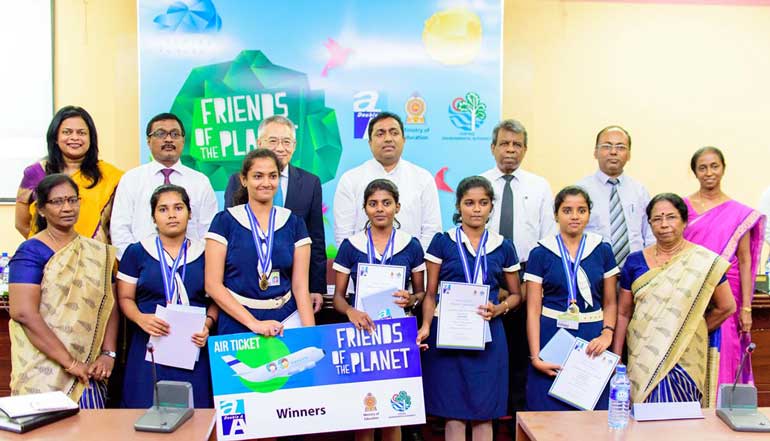
Double A Sri Lanka rewards winners of ‘Friends of the Planet’ campaign
Back row (from left): Chethika Hapugalle, General Manager, Double A Pulp and Paper Company Sri Lanka; A.S. Hewage, Additional Secretary – School Activates – Ministry of Education; Thirawit Leetavorn, Vice President, Double A Pulp and Paper Company Limited; Akila Viraj Kariyawasam, Minister of Education; W.M. Bandusena, Secretary, Ministry of Education; M. J. J. Fernando, DDG – Environmental Education & Awareness Division, Central Environmental Authority; and Damayanthi Balasuriya Director of Education – Agriculture and Environmental Studies. Front row (from left): A. Thevakanthan (Project Teacher, Vincent Girls’ High School, Batticaloa), students Primraj Ravichandra, Abarna Kumarakuruparan, Litharshika Sadatchararajah, Thuwaraha Suntharalingam, Tharshana Thevaraj and Principal, Vincent Girls’ High School, Batticaloa R. Kanagasingam
Vincent Girls’ High School, Batticaloa emerged Overall Winners in the final round of the ‘Friends of the Planet’ project conducted by Double A in collaboration with the Ministry of Education and the Central Environmental Authority.
Mayurapada Central College, Narammala and Pallivasalthurai Muslim Maha Vidyalayam, Kalpitiya clinched second and third place respectively.
The awards ceremony was held recently at the Ministry of Education auditorium. The Chief Guest at the occasion was Education Minister Akila Viraj Kariyawasam. Also present were Prof. Lal Mervin Dharmasiri from the Central Environmental Authority and Thirawit Leetavorn, Senior Executive Vice President of the Double A (1991) Public Company Ltd.
Members of Vincent Girls’ High School, Batticaloa were given tablets and will be sent on an all-expenses-paid trip to Thailand where they will see the award-winning KHAN-NA sustainability project carried out by Double A.
The paper from the KHAN-NA project is a landmark effort to make optimum use of the vacant space between rice fields in Thailand, owned by local farmers. During the process, the KHAN-NA project’s previous unproductive land is transformed into a productive resource, which provides additional income to over 1.5 million farmers when they sell the sustainable fibre-source back to Double A.
The teams from Mayurapada Central College, Narammala and Pallivasalthurai Muslim Maha Vidyalayam, Kalpitiya received valuable tablets and certificates.
Double A ‘Friends of the Planet’ is a CSR project which was initiated in February 2016 to promote and educate schoolchildren island-wide on environmental protection. Seven schools were selected to implement their innovative projects under the guidance of the Ministry of Education Director of Education (Agriculture and Environmental Studies) and the Central Environmental Authority. This project was monitored by the Director of Education (Agriculture and Environmental Studies) and the Central Environmental Authority.
According to the campaign guidelines, the competing schools selected a team of five students above the age of 15 to come up with a cost-effective and groundbreaking solution to an environmental problem.
Under the guidance of a teacher, each team developed and implemented a project within a period of three months. Upon completing the project each team compiled a detailed report which they presented to the expert panel of judges from Double A for evaluation.
“We are pleased to announce the winners who, with their creativity and intellect, were able to craft solutions to larger problems and awareness of how important it is for everyone to band together to save the planet. Armed with innovative ideas, these students are important stakeholders in a new way of life that will help save the planet. Judging from the success of this particular campaign, our belief in young minds was well-founded,” said Leetavorn, who flew into Colombo for the ceremony.
Leetavorn is the Senior Executive Vice President of Double A. He is a key member of the team leading the global consumer expansion of the Double A brand. He currently leads market development for Europe and the Americas.
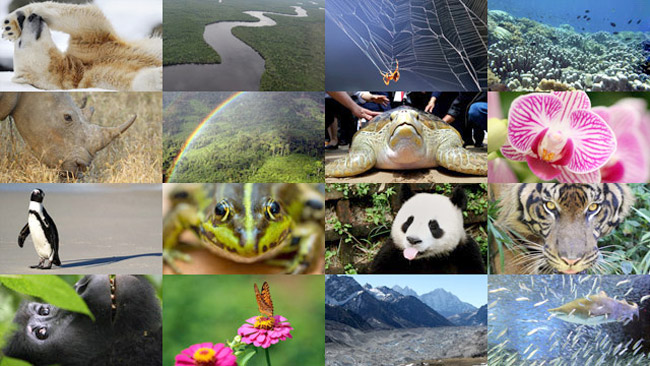
Biodiversity greater inside Earth’s protected areas
Biodiversity is greater inside the world’s protected areas, scientists have been able to show for the first time.
There are 15% more individual plants and animals and 11% more species inside than outside protected areas, according to the largest analysis of biodiversity in terrestrial globally protected areas to date.
The study, carried out by the University of Sussex, the Natural History Museum and the UN Environment Programme’s World Conservation Monitoring Centre, analysed biodiversity samples taken from 1,939 sites inside and 4,592 sites outside protected areas.
“We have been able to show for the first time how protection effects thousands of species, including plants, mammals, birds and insects. This has provided us with important insights into these areas – which previous studies were not able to do,” said co-lead author of the study, Dr Claudia Gray, from the University of Sussex.
Protected areas are widely considered essential for biodiversity conservation.
However there has been some doubt over their success, with problems including lack of effective management, increasing human pressures and inadequate government support.
Currently around 15% of the world’s land and 3% of the oceans are protected, and the Convention on Biological Diversity has pledged that this will rise to at least 17% of land and 10% of marine areas by 2020.
New global biodiversity database
But these results demonstrate that protection zones do benefit a broad range of species, and governments must continue to recognise and support them, said Dr Jörn Scharlemann, from the University of Sussex.
“Protected areas do not currently benefit all species – but what we have shown in our study is they have the potential to help us conserve some of the most biodiverse areas on Earth – which is why they vitally need increased global support.”
The study used a relatively new global biodiversity database called Predicts (Projecting Responses of Ecological Diversity In Changing Terrestrial Systems), which contains field data from hundreds of scientists documenting how local terrestrial biodiversity responds to human impacts.
The nearly four-year-old project has unprecedented geographic and taxonomic coverage, with more than 2.5 m biodiversity records from more than 21,000 sites, covering more than 38,000 species.
However this data only accounts for around 1% of all known species.
Previous regional or global studies of protected areas were limited to relying on information from satellite photos to examine changes in forest cover.
Prof Andy Purvis, one of the paper’s authors from the Natural History Museum, said: “This study shows how important questions in conservation biology can be tackled by joining forces. Hundreds of scientists from dozens of countries have generously shared their hard-earned data with us. Each one of those data sets is like a piece of a jigsaw: the overall picture only becomes clear when you have all the pieces and can put them together.”
Needs of our ever-growing population
The study, published in the journal Nature Communications, also showed that protection is most effective when human use of land for farming is minimised, suggesting better management of existing protected areas could more than double their effectiveness.
The global protected area network was 41% effective at retaining species richness and abundance, the paper judged.
Dr Samantha Hill, from the UN Environment Programme’s World Conservation Monitoring Centre, said: “Humanity faces difficult decisions as to how best to protect biodiversity while providing for the needs of our ever-growing population. This study provides new understanding into the biodiversity found at the intersection of protected areas and human land-uses.
(Souce :30/07/2016 Daily News http://www.dailynews.lk/?q=2016/07/30/features/88973)
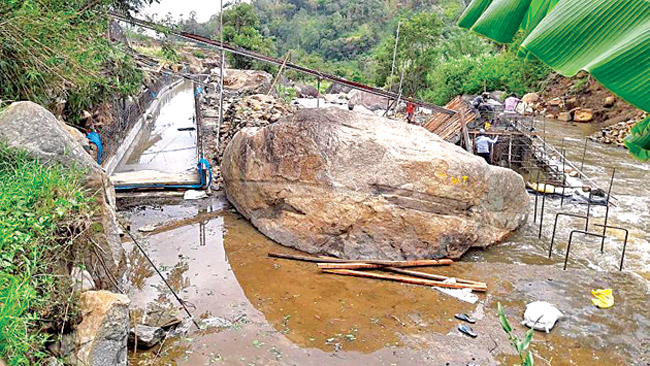
Call to protect environment from mini-hydro power projects
Rainforest protectors in Sri Lanka requested the authorities to take immediate corrective steps to stop the destruction taking place due to the rapidly spreading mini-hydro power projects throughout the wet zone. They urged that the national policy on renewable energy be focused on technologies that do not cause ecological destruction to catchment areas.
According to rainforest protectors, water sources, including main streams around Mandaram Nuwara and Hanguranketha have became the latest victims of the rapidly spreading mini-hydro projects. They have became a threat to the livelihoods of the people in these areas.
Agriculture is the main livelihood of the people in the Hanguranketha, Walapane, Delthota and Pathahewaheta Divisional Secretariat Divisions. They are fulfilling their water requirement mainly from Belihul Oya, Ma Oya, Thalathu Oya and Marassana Oya. These areas have faced a huge threat with the commence of the construction of new mini-hydro power plants.
Social, economical and environmental issues are rising up with the construction of the Deegalhinna mini-hydro project based on Deegal Oya. More than 300 acres of paddy fields around one kilometre of Deegal Oya have gone dry due to the obstruction of water supply. New hydro projects have caused the drying of Ethawatunuwala waterfall and Deegalahinna waterfall by threatening endemic plants and animals.
Source : Daily News 30/07/2016 http://www.dailynews.lk/?q=2016/07/30/local/89011












